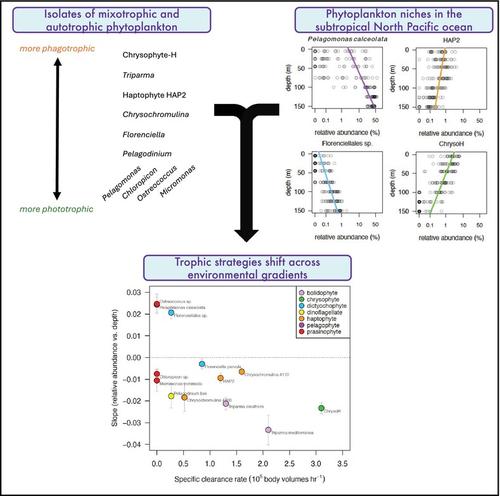当前位置:
X-MOL 学术
›
Environ. Microbiol.
›
论文详情
Our official English website, www.x-mol.net, welcomes your
feedback! (Note: you will need to create a separate account there.)
Trophic strategies of picoeukaryotic phytoplankton vary over time and with depth in the North Pacific Subtropical Gyre
Environmental Microbiology ( IF 4.3 ) Pub Date : 2024-08-22 , DOI: 10.1111/1462-2920.16689 Kyle F Edwards 1 , Yoshimi M Rii 2 , Qian Li 3 , Logan M Peoples 4 , Matthew J Church 4 , Grieg F Steward 5
Environmental Microbiology ( IF 4.3 ) Pub Date : 2024-08-22 , DOI: 10.1111/1462-2920.16689 Kyle F Edwards 1 , Yoshimi M Rii 2 , Qian Li 3 , Logan M Peoples 4 , Matthew J Church 4 , Grieg F Steward 5
Affiliation

|
In oligotrophic oceans, the smallest eukaryotic phytoplankton are both significant primary producers and predators of abundant bacteria such as Prochlorococcus . However, the drivers and consequences of community dynamics among these diverse protists are not well understood. Here, we investigated how trophic strategies along the autotrophy‐mixotrophy spectrum vary in importance over time and across depths at Station ALOHA in the North Pacific Subtropical Gyre. We combined picoeukaryote community composition from a 28‐month time‐series with traits of diverse phytoplankton isolates from the same location, to examine trophic strategies across 13 operational taxonomic units and 8 taxonomic classes. We found that autotrophs and slower‐grazing mixotrophs tended to prevail deeper in the photic zone, while the most voracious mixotrophs were relatively abundant near the surface. Within the mixed layer, there was greater phagotrophy when conditions were most stratified and when Chl a concentrations were lowest, although the greatest temporal variation in trophic strategy occurred at intermediate depths (45–100 m). Dynamics at this site are consistent with previously described spatial patterns of trophic strategies. The success of relatively phagotrophic phytoplankton at shallower depths in the most stratified waters suggests that phagotrophy is a competitive strategy for acquiring nutrients when energy from light is plentiful.
中文翻译:

北太平洋副热带环流中超微核浮游植物的营养策略随时间和深度而变化
在寡营养海洋中,最小的真核浮游植物既是重要的初级生产者,又是丰富细菌的捕食者,例如原绿球藻属。然而,这些不同的原生生物群落动态的驱动因素和后果尚不清楚。在这里,我们研究了北太平洋副热带环流 ALOHA 站自养-混合营养谱上的营养策略的重要性如何随时间和深度变化。我们将 28 个月时间序列的超微真核生物群落组成与同一地点的不同浮游植物分离株的特征相结合,以检查 13 个操作分类单元和 8 个分类纲的营养策略。我们发现自养生物和放牧速度较慢的混合营养生物往往在透光区较深处占主导地位,而最贪婪的混合营养生物则在地表附近相对丰富。在混合层内,当条件分层程度最高且叶绿素含量最高时,吞噬作用更强。一个尽管营养策略的最大时间变化发生在中间深度(45-100 m),但浓度最低。该地点的动态与先前描述的营养策略的空间模式一致。在最分层水域的较浅深度,相对吞噬性浮游植物的成功表明,当光能充足时,吞噬性是获取营养物的竞争策略。
更新日期:2024-08-22
中文翻译:

北太平洋副热带环流中超微核浮游植物的营养策略随时间和深度而变化
在寡营养海洋中,最小的真核浮游植物既是重要的初级生产者,又是丰富细菌的捕食者,例如原绿球藻属。然而,这些不同的原生生物群落动态的驱动因素和后果尚不清楚。在这里,我们研究了北太平洋副热带环流 ALOHA 站自养-混合营养谱上的营养策略的重要性如何随时间和深度变化。我们将 28 个月时间序列的超微真核生物群落组成与同一地点的不同浮游植物分离株的特征相结合,以检查 13 个操作分类单元和 8 个分类纲的营养策略。我们发现自养生物和放牧速度较慢的混合营养生物往往在透光区较深处占主导地位,而最贪婪的混合营养生物则在地表附近相对丰富。在混合层内,当条件分层程度最高且叶绿素含量最高时,吞噬作用更强。一个尽管营养策略的最大时间变化发生在中间深度(45-100 m),但浓度最低。该地点的动态与先前描述的营养策略的空间模式一致。在最分层水域的较浅深度,相对吞噬性浮游植物的成功表明,当光能充足时,吞噬性是获取营养物的竞争策略。


















































 京公网安备 11010802027423号
京公网安备 11010802027423号